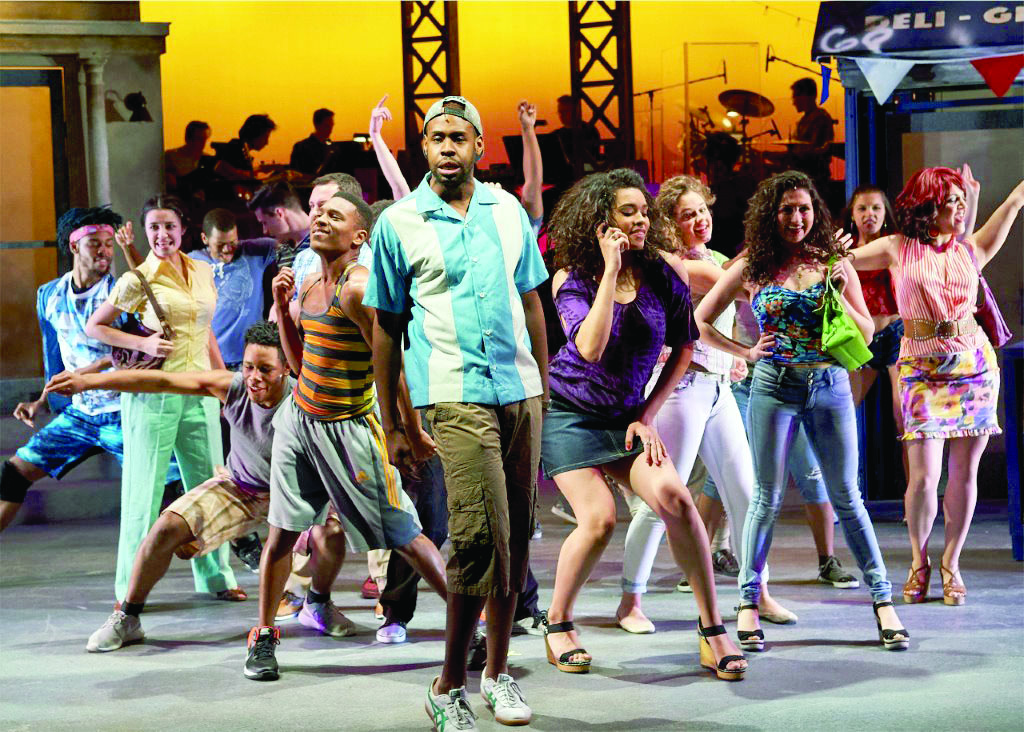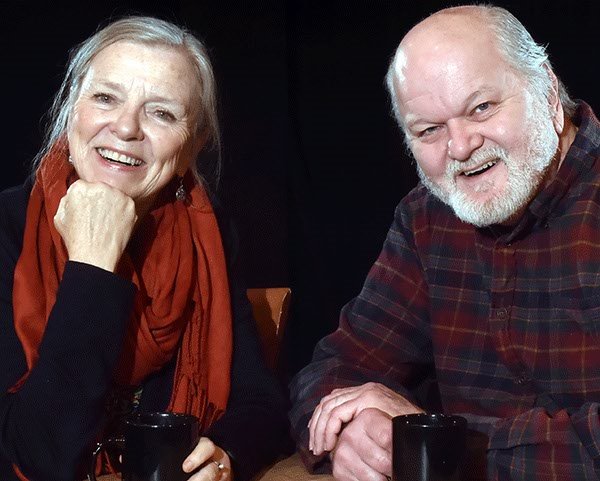By Carlo Wolff

Photo / Bob Perkoski / LAND studio.
Enter MetroHealth’s Glick Center on Cleveland’s west side and one of the first artworks you’re likely to encounter is “Here We Are,” a slide show by Cleveland photographer McKinley Wiley, playing on a big screen. Designed to celebrate the Clark-Fulton neighborhood that is home to the MetroHealth hospital system’s main campus, Wiley’s images show area residents at play, at work and improving their community. Wiley’s welcoming work is a display about pride of place.
The 11-story, 380-bed MetroHealth Glick Center is the centerpiece of a $946 million transformation of the hospital system. It blends art and health, showcasing art in its hallways and patient rooms, and tailoring it to the practice: no potentially disturbing abstractions in an area treating dementia, for example, but playful displays of nature and wildlife in the pediatric playroom.
Airy and spacious, the Glick Center lobby is home to more unusual, largely local art. Lynnea Holland Weiss’ “Embrace” is a startlingly vivid, startlingly large acrylic on drywall showing a couple locked in love. The comforting work grounds both viewer and room. It’s a powerful, creative combination of the soothing and the edgy, a perfect backdrop to the ground-floor dining area.

Look up and you’ll see “100 colors no. 39, sunshine,” Emmanuelle Moureaux’s ceiling installation. An aspirational assemblage of 1,638 acrylic modules in 100 color shades, it’s a giddy, joyous abstraction. Like the other pieces in the hospital system’s collection, it is part of a program to “inspire a transformative experience for every person who engages with the health care system,” according to MetroHealth’s Center for Arts. The collection, which is still growing, “will embody MetroHealth’s global diversity and local focus, and inspire a sense of hope, healing and community,” the center’s mission statement says.
Open only since last November, the new MetroHealth collection is the baby on the Cleveland region’s corporate art block. Similar statements inform the art collections at Cleveland Clinic and University Hospitals.
“We look for art that is unique in concept and execution and that promotes healing in various ways,” says Ellen Rudolph, the Clinic’s curator and senior director.
While art has a long history of decorating these places where patients receive care and heal, research suggests well-placed artwork contributes to an atmosphere where they feel safe and maintain a connection to the outside world. And for these local health care systems, it’s become customary to spotlight local artists and arts organizations, contributing to a mutually beneficial dynamic between the hospital industry and the artistic community.

Photo / Courtesy of Ebony Patterson and Carolina Nitsch Contemporary Art.
GLICK CENTER VISION
Curated by the hospital system’s Center for Arts and LAND Studio, the MetroHealth collection includes 1,008 pieces. Of those, 695 are unique works, and of those, 74% are by local artists or artists with local connections.
If original, contemporary art is the backbone of the new MetroHealth complex – named for Bob and JoAnn Glick of Hunting Valley, who contributed $42 million for hospital system programming, not bricks and mortar – its ambitions go beyond the contemplative, suggests Linda Jackson, director of its Center for Arts in Health.
“The visual arts program is curated by the Center for Arts and Health, but that’s not all we do to provide art, music therapy and patient care,” says Jackson, who has been working on MetroHealth’s new art programming for going on eight years. “We can bring arts and health programming for patients, for staff, for the community. This whole ground floor area is open to the public, so someone can come have lunch here. We have live musicians here, and they can come and see that, too.
“We’re just getting going,” Jackson says. “We’re letting everybody try to get their feet on the ground in the new building first, then we’ll add more.”
LAND Studio, a Cleveland specialist in art in public spaces, is sure to help in this ongoing effort.
While the overall themes of MetroHealth are hope, healing and community, LAND also worked “to make sure the artwork was appropriate for each unit,” says Erin Guido, LAND project supervisor. “There were a lot of considerations in terms of the needs of patients and staff, and in the public spaces, making a space that was welcoming and celebrated the community.”
Clark-Fulton is the most Hispanic neighborhood in Cleveland, and the Glick Center is shaping up to be its anchor.
“Because we’ve been working with MetroHealth for years, we created mini-stakeholder groups of patients and staff – that’s how we come up with themes,” Guido says, citing “many stakeholders meetings homing in on the direction of the art collection.”
One of the most intriguing pieces in the new Glick Center collection is the product of a kind of hive mind. Crafted by the Cleveland branding and graphic design firm Agnes Studio, “Figures 1-832” is four digitally created giclee prints articulating the responses of nearly 900 of the 8,000 MetroHealth employees to questions about their work experience, what kind of art calms them and what colors give them hope.
Using that caregiver input, Agnes Studio arranged the data, separating staff members by birth month and grouping the information in three-month batches. A closer look reveals the participant’s name on the left, their MetroHealth tenure to the right. It’s an aesthetic, provocative record of institutional fact and character.
“It’s such a special piece because it really represents the staff,” says Jackson, “and how many individuals make this really important.”
THE ESTABLISHMENT
What of the other Cleveland-based hospital art collections? Let’s start with the biggest, the Cleveland Clinic. The hospital system displays its nearly 7,000 artworks in 165 locations in Ohio, Florida, Las Vegas, Toronto, London and Abu Dhabi. The works, in various media, represent artists from 85 countries. Of the artists featured, 40% are women, and 20% have ties to Ohio. The Clinic boasts 50 site-specific commissions.
“My team does all the selecting, purchasing and placement of the art, with the exception of gifts of art and large-scale commissioned works, which are reviewed and approved by hospital leadership,” Rudolph says.
The Clinic seeks art that is unique in its subject matter and how it was created, and that which nurtures healing in some way, she says.
“That could be by offering moments of calm, respite or escape, by sparking wonder and curiosity, or by making a person feel seen. … Practically speaking, we have to consider how an artwork will fare in the hospital environment, where there can be high traffic, bright light, gurneys … carts and more.”

The needs of patients and staff influence the selection and placement of art. So does the purpose of a space, Rudolph says.
The effect of art is undeniably healthy, she suggests, citing two studies “demonstrating that the art is effective at reducing stress, pain levels and blood pressure, and improving mood.
“Regional artists and galleries are an important part of our research and acquisition process,” Rudolph adds. “We’d like to engage the community in a more robust dialogue around how contemporary art functions in living environments.”
Engagement with the local art scene is also important to Thomas Huck, art curator for University Hospitals.
“I’m very familiar with the local galleries and artists as I myself used to be among them” says Huck, who oversees about 3,200 works across the UH system.
“We look to support the Northeast Ohio market as much as possible, as our region has an abundance of talent,” he says. “We are very proud to have numerous regional artists represented in the collection, coupled with a high-profile exhibition program at our main campus. This unique opportunity provides a 24/7 platform for artists to exhibit and sell their work.
Like the other hospitals, Huck and UH also carefully decide which pieces are right for diverse patient populations, he says.
“For example, we will appoint certain types of subjects throughout our pediatric areas, another type of work within our men’s and women’s health clinics, yet other subjects that are more appropriate for cancer patient areas,” he says. “Some of our more progressive contemporary works that may not be ideal for patient care areas find their way into administrative areas.”

Photo / Tom Huck
What persuades Huck’s department to acquire a work of art for UH?
“Imagery alignment with the collection’s mission, inspiration behind the piece, relevance to specific patient populations, artist background, medium diversity and often scale all play a factor in our decisions,” he says.
Jackson, the driving force behind the new MetroHealth collection, adds the process toward creating the hospital’s artistic environment is “very inclusive.” Assembling the collection “was extremely meaningful in that our team was completely involved in picking and looking at different artists’ work and working directly with artists on behalf of patients and families,” she says.
“It meant so much to us to be involved in that process, and the anecdotal feedback we continue to provide shows how important this artwork is to us and our families,” Jackson says.










